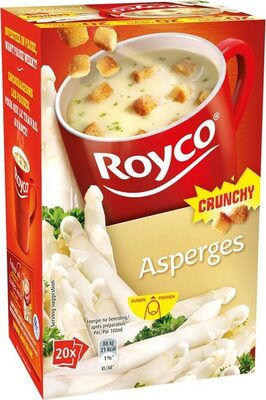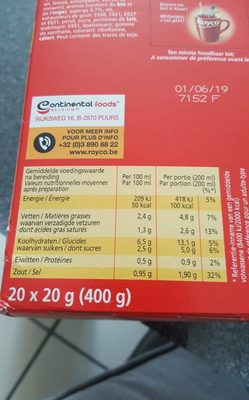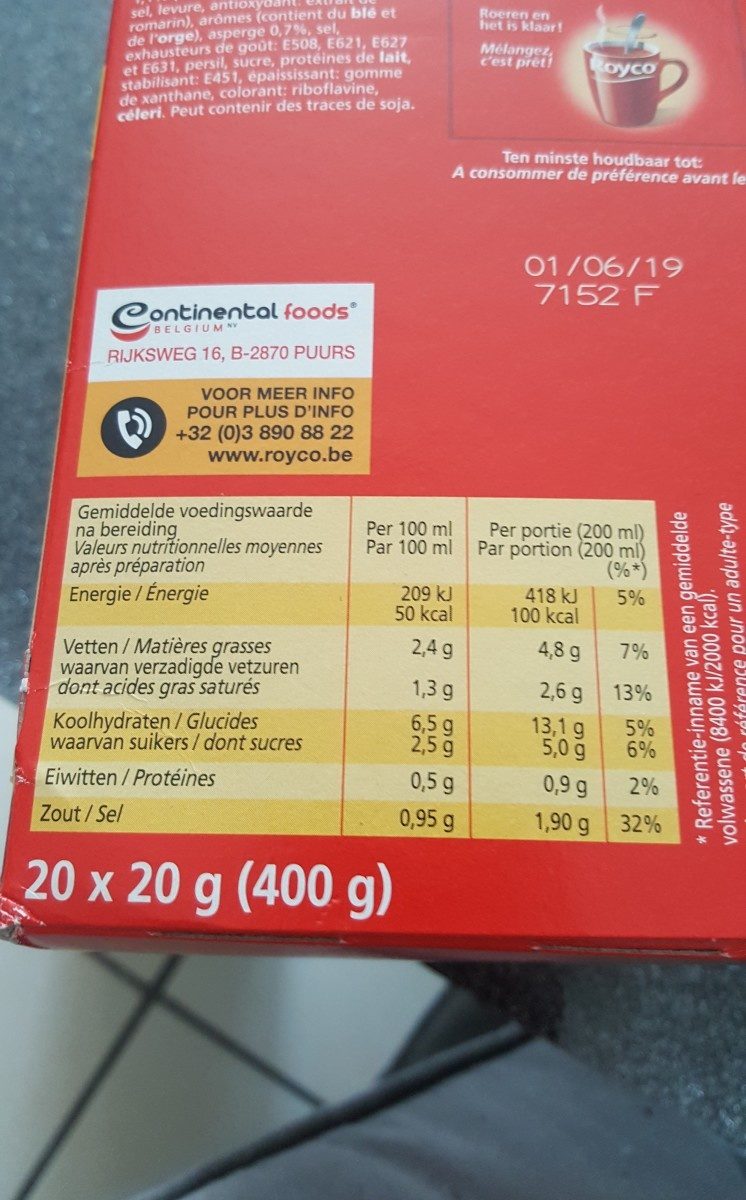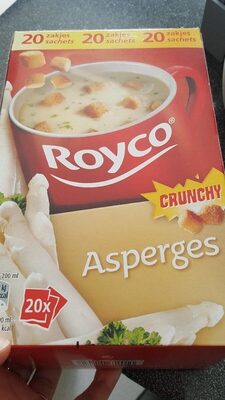Help us make food transparency the norm!
As a non-profit organization, we depend on your donations to continue informing consumers around the world about what they eat.
The food revolution starts with you!
Soupes Instantanées Royco Asperges Aux Croûtons 20 Unités - 20 x 20 g
Soupes Instantanées Royco Asperges Aux Croûtons 20 Unités - 20 x 20 g
This product page is not complete. You can help to complete it by editing it and adding more data from the photos we have, or by taking more photos using the app for Android or iPhone/iPad. Thank you!
×
Barcode: 5410056187450 (EAN / EAN-13)
Quantity: 20 x 20 g
Brands: Royco
Categories: Plant-based foods and beverages, Plant-based foods, Fruits and vegetables based foods, Meals, Dried products, Dried products to be rehydrated, Soups, Dried meals, Reheatable soups, Vegetable soups, Dehydrated soups, Asparagus soups, Dehydrated vegetable soups
Countries where sold: France
Matching with your preferences
Health
Ingredients
-
30 ingredients
: du potage après préparation avcc 200 ml d'eau: eau, amidon de pomme de terre, sirop de glucose, graisse de palme, croûtons 1,1 % (farine de blé, graisse de palme, sel, levure, antioxydant: extrait de romarin), arômes (contient du blé et de l'orge), asperge 0,7%, sel, exhausteurs de goùt: E508, E621, E627 et E631, persil, sucre, protéines de lait, stabilisant: E451, épaississant: gomme de xanthane, colorant: riboflavine, céleri. Peut contenir des traces de soja.Allergens: Celery, Gluten, MilkTraces: Soybeans
Food processing
-
Ultra processed foods
Elements that indicate the product is in the 4 - Ultra processed food and drink products group:
- Additive: E101 - Riboflavin
- Additive: E415 - Xanthan gum
- Additive: E451 - Triphosphates
- Additive: E621 - Monosodium glutamate
- Additive: E627 - Disodium guanylate
- Additive: E631 - Disodium inosinate
- Ingredient: Colour
- Ingredient: Flavour enhancer
- Ingredient: Flavouring
- Ingredient: Glucose
- Ingredient: Glucose syrup
- Ingredient: Milk proteins
- Ingredient: Thickener
Food products are classified into 4 groups according to their degree of processing:
- Unprocessed or minimally processed foods
- Processed culinary ingredients
- Processed foods
- Ultra processed foods
The determination of the group is based on the category of the product and on the ingredients it contains.
Additives
-
E101 - Riboflavin
Riboflavin: Riboflavin, also known as vitamin B2, is a vitamin found in food and used as a dietary supplement. Food sources include eggs, green vegetables, milk and other dairy product, meat, mushrooms, and almonds. Some countries require its addition to grains. As a supplement it is used to prevent and treat riboflavin deficiency and prevent migraines. It may be given by mouth or injection.It is nearly always well tolerated. Normal doses are safe during pregnancy. Riboflavin is in the vitamin B group. It is required by the body for cellular respiration.Riboflavin was discovered in 1920, isolated in 1933, and first made in 1935. It is on the World Health Organization's List of Essential Medicines, the most effective and safe medicines needed in a health system. Riboflavin is available as a generic medication and over the counter. In the United States a month of supplements costs less than 25 USD.Source: Wikipedia
-
E101i - Riboflavin
Riboflavin: Riboflavin, also known as vitamin B2, is a vitamin found in food and used as a dietary supplement. Food sources include eggs, green vegetables, milk and other dairy product, meat, mushrooms, and almonds. Some countries require its addition to grains. As a supplement it is used to prevent and treat riboflavin deficiency and prevent migraines. It may be given by mouth or injection.It is nearly always well tolerated. Normal doses are safe during pregnancy. Riboflavin is in the vitamin B group. It is required by the body for cellular respiration.Riboflavin was discovered in 1920, isolated in 1933, and first made in 1935. It is on the World Health Organization's List of Essential Medicines, the most effective and safe medicines needed in a health system. Riboflavin is available as a generic medication and over the counter. In the United States a month of supplements costs less than 25 USD.Source: Wikipedia
-
E415 - Xanthan gum
Xanthan gum (E415) is a natural polysaccharide derived from fermented sugars, often used in the food industry as a thickening and stabilizing agent.
This versatile food additive enhances texture and prevents ingredient separation in a wide range of products, including salad dressings, sauces, and gluten-free baked goods.
It is considered safe for consumption even at high intake amounts.
-
E451 - Triphosphates
Sodium triphosphate: Sodium triphosphate -STP-, also sodium tripolyphosphate -STPP-, or tripolyphosphate -TPP-,- is an inorganic compound with formula Na5P3O10. It is the sodium salt of the polyphosphate penta-anion, which is the conjugate base of triphosphoric acid. It is produced on a large scale as a component of many domestic and industrial products, especially detergents. Environmental problems associated with eutrophication are attributed to its widespread use.Source: Wikipedia
-
E508 - Potassium chloride
Potassium chloride: Potassium chloride -KCl- is a metal halide salt composed of potassium and chlorine. It is odorless and has a white or colorless vitreous crystal appearance. The solid dissolves readily in water and its solutions have a salt-like taste. KCl is used as a fertilizer, in medicine, in scientific applications, and in food processing. In a few states of the United States it is used to cause cardiac arrest as the third drug in the "three drug cocktail" for executions by lethal injection. It occurs naturally as the mineral sylvite, and in combination with sodium chloride as sylvinite.The version for injection is on the World Health Organization's List of Essential Medicines, the most important medications needed in a basic health system.Source: Wikipedia
-
E621 - Monosodium glutamate
Monosodium glutamate: Monosodium glutamate -MSG, also known as sodium glutamate- is the sodium salt of glutamic acid, one of the most abundant naturally occurring non-essential amino acids. Glutamic acid is found naturally in tomatoes, grapes, cheese, mushrooms and other foods.MSG is used in the food industry as a flavor enhancer with an umami taste that intensifies the meaty, savory flavor of food, as naturally occurring glutamate does in foods such as stews and meat soups. It was first prepared in 1908 by Japanese biochemist Kikunae Ikeda, who was trying to isolate and duplicate the savory taste of kombu, an edible seaweed used as a base for many Japanese soups. MSG as a flavor enhancer balances, blends, and rounds the perception of other tastes.The U.S. Food and Drug Administration has given MSG its generally recognized as safe -GRAS- designation. A popular belief is that large doses of MSG can cause headaches and other feelings of discomfort, known as "Chinese restaurant syndrome," but double-blind tests fail to find evidence of such a reaction. The European Union classifies it as a food additive permitted in certain foods and subject to quantitative limits. MSG has the HS code 29224220 and the E number E621.Source: Wikipedia
-
E627 - Disodium guanylate
Disodium guanylate: Disodium guanylate, also known as sodium 5'-guanylate and disodium 5'-guanylate, is a natural sodium salt of the flavor enhancing nucleotide guanosine monophosphate -GMP-. Disodium guanylate is a food additive with the E number E627. It is commonly used in conjunction with glutamic acid. As it is a fairly expensive additive, it is not used independently of glutamic acid; if disodium guanylate is present in a list of ingredients but MSG does not appear to be, it is likely that glutamic acid is provided as part of another ingredient such as a processed soy protein complex. It is often added to foods in conjunction with disodium inosinate; the combination is known as disodium 5'-ribonucleotides. Disodium guanylate is produced from dried seaweed and is often added to instant noodles, potato chips and other snacks, savory rice, tinned vegetables, cured meats, and packaged soup.Source: Wikipedia
-
E631 - Disodium inosinate
Disodium inosinate: Disodium inosinate -E631- is the disodium salt of inosinic acid with the chemical formula C10H11N4Na2O8P. It is used as a food additive and often found in instant noodles, potato chips, and a variety of other snacks. Although it can be obtained from bacterial fermentation of sugars, it is often commercially prepared from animal sources.Source: Wikipedia
Ingredients analysis
-
Palm oil
Ingredients that contain palm oil: Palm fat, Palm fat
-
Non-vegan
Non-vegan ingredients: Milk proteinsSome ingredients could not be recognized.
We need your help!
You can help us recognize more ingredients and better analyze the list of ingredients for this product and others:
- Edit this product page to correct spelling mistakes in the ingredients list, and/or to remove ingredients in other languages and sentences that are not related to the ingredients.
- Add new entries, synonyms or translations to our multilingual lists of ingredients, ingredient processing methods, and labels.
If you would like to help, join the #ingredients channel on our Slack discussion space and/or learn about ingredients analysis on our wiki. Thank you!
-
Vegetarian status unknown
Unrecognized ingredients: fr:du-potage-apres-preparation-avcc-200-ml-d-eau, CroutonSome ingredients could not be recognized.
We need your help!
You can help us recognize more ingredients and better analyze the list of ingredients for this product and others:
- Edit this product page to correct spelling mistakes in the ingredients list, and/or to remove ingredients in other languages and sentences that are not related to the ingredients.
- Add new entries, synonyms or translations to our multilingual lists of ingredients, ingredient processing methods, and labels.
If you would like to help, join the #ingredients channel on our Slack discussion space and/or learn about ingredients analysis on our wiki. Thank you!
-
Details of the analysis of the ingredients
We need your help!
Some ingredients could not be recognized.
We need your help!
You can help us recognize more ingredients and better analyze the list of ingredients for this product and others:
- Edit this product page to correct spelling mistakes in the ingredients list, and/or to remove ingredients in other languages and sentences that are not related to the ingredients.
- Add new entries, synonyms or translations to our multilingual lists of ingredients, ingredient processing methods, and labels.
If you would like to help, join the #ingredients channel on our Slack discussion space and/or learn about ingredients analysis on our wiki. Thank you!
: du potage après préparation avcc 200 ml d'eau (eau), amidon de pomme de terre, sirop de glucose, graisse de palme, croûtons 1.1% (farine de blé, graisse de palme, sel, levure, antioxydant (extrait de romarin)), arômes (), asperge 0.7%, sel, exhausteurs de goùt (e508), e621, e627, e631, persil, sucre, protéines de lait, stabilisant (e451), épaississant (gomme de xanthane), colorant (riboflavine), céleri- du potage après préparation avcc 200 ml d'eau -> fr:du-potage-apres-preparation-avcc-200-ml-d-eau - percent_min: 5.26315789473684 - percent_max: 94.2
- eau -> en:water - vegan: yes - vegetarian: yes - ciqual_food_code: 18066 - percent_min: 5.26315789473684 - percent_max: 94.2
- amidon de pomme de terre -> en:potato-starch - vegan: yes - vegetarian: yes - ciqual_proxy_food_code: 9510 - percent_min: 1.1 - percent_max: 47.65
- sirop de glucose -> en:glucose-syrup - vegan: yes - vegetarian: yes - ciqual_proxy_food_code: 31016 - percent_min: 1.1 - percent_max: 32.1333333333333
- graisse de palme -> en:palm-fat - vegan: yes - vegetarian: yes - from_palm_oil: yes - ciqual_proxy_food_code: 16129 - percent_min: 1.1 - percent_max: 24.375
- croûtons -> en:crouton - ciqual_food_code: 7430 - percent_min: 1.1 - percent: 1.1 - percent_max: 1.1
- farine de blé -> en:wheat-flour - vegan: yes - vegetarian: yes - ciqual_proxy_food_code: 9410 - percent_min: 0.22 - percent_max: 1.1
- graisse de palme -> en:palm-fat - vegan: yes - vegetarian: yes - from_palm_oil: yes - ciqual_proxy_food_code: 16129 - percent_min: 0 - percent_max: 0.55
- sel -> en:salt - vegan: yes - vegetarian: yes - ciqual_food_code: 11058 - percent_min: 0 - percent_max: 0.366666666666667
- levure -> en:yeast - vegan: yes - vegetarian: yes - percent_min: 0 - percent_max: 0.275
- antioxydant -> en:antioxidant - percent_min: 0 - percent_max: 0.275
- extrait de romarin -> en:e392 - vegan: yes - vegetarian: yes - percent_min: 0 - percent_max: 0.275
- arômes -> en:flavouring - vegan: maybe - vegetarian: maybe - percent_min: 0.7 - percent_max: 0
- asperge -> en:asparagus - vegan: yes - vegetarian: yes - percent_min: 0.7 - percent: 0.7 - percent_max: 0
- sel -> en:salt - vegan: yes - vegetarian: yes - ciqual_food_code: 11058 - percent_min: 0 - percent_max: 0
- exhausteurs de goùt -> en:flavour-enhancer - percent_min: 0 - percent_max: 0
- e508 -> en:e508 - vegan: yes - vegetarian: yes - percent_min: 0 - percent_max: 0
- e621 -> en:e621 - vegan: yes - vegetarian: yes - percent_min: 0 - percent_max: 0
- e627 -> en:e627 - vegan: maybe - vegetarian: maybe - percent_min: 0 - percent_max: 0
- e631 -> en:e631 - vegan: maybe - vegetarian: maybe - percent_min: 0 - percent_max: 0
- persil -> en:parsley - vegan: yes - vegetarian: yes - ciqual_proxy_food_code: 11014 - percent_min: 0 - percent_max: 0
- sucre -> en:sugar - vegan: yes - vegetarian: yes - ciqual_proxy_food_code: 31016 - percent_min: 0 - percent_max: 0
- protéines de lait -> en:milk-proteins - vegan: no - vegetarian: yes - percent_min: 0 - percent_max: 0
- stabilisant -> en:stabiliser - percent_min: 0 - percent_max: 0
- e451 -> en:e451 - vegan: yes - vegetarian: yes - percent_min: 0 - percent_max: 0
- épaississant -> en:thickener - percent_min: 0 - percent_max: 0
- gomme de xanthane -> en:e415 - vegan: yes - vegetarian: yes - percent_min: 0 - percent_max: 0
- colorant -> en:colour - percent_min: 0 - percent_max: 0
- riboflavine -> en:e101 - vegan: maybe - vegetarian: yes - percent_min: 0 - percent_max: 0
- céleri -> en:celery - vegan: yes - vegetarian: yes - ciqual_proxy_food_code: 20055 - percent_min: 0 - percent_max: 0
-
Nutrition facts
Nutrition facts As sold
for 100 g / 100 mlCompared to: Asparagus soups Energy 209 kj
(50 kcal)+6% Fat 2.4 g -10% Saturated fat 1.3 g +33% Carbohydrates 6.5 g +47% Sugars 2.5 g +180% Fiber ? Proteins 0.5 g -59% Salt 0.95 g +21% Fruits‚ vegetables‚ nuts and rapeseed‚ walnut and olive oils (estimate from ingredients list analysis) 4.198 %
Environment
-
Eco-Score C - Moderate environmental impact
⚠ ️Select a country in order to include the full impact of transportation.The Eco-Score is an experimental score that summarizes the environmental impacts of food products.→ The Eco-Score was initially developped for France and it is being extended to other European countries. The Eco-Score formula is subject to change as it is regularly improved to make it more precise and better suited to each country.Life cycle analysis
-
Average impact of products of the same category: A (Score: 89/100)
Category: Soup, asparagus, prepacked, to be reheated
Category: Soup, asparagus, prepacked, to be reheated
- PEF environmental score: 0.21 (the lower the score, the lower the impact)
- including impact on climate change: 1.50 kg CO2 eq/kg of product
Stage Impact Agriculture
38.6 %Processing
38.6 %Packaging
4.9 %Transportation
13.8 %Distribution
2.2 %Consumption
2.0 %
Bonuses and maluses
-
Missing origins of ingredients information
Malus: -5
⚠ ️ The origins of the ingredients of this product are not indicated.
If they are indicated on the packaging, you can modify the product sheet and add them.
If you are the manufacturer of this product, you can send us the information with our free platform for producers.
-
Ingredients that threatens species
Malus: -10
Contains palm oil
Tropical forests in Asia, Africa and Latin America are destroyed to create and expand oil palm tree plantations. The deforestation contributes to climate change, and it endangers species such as the orangutan, the pigmy elephant and the Sumatran rhino.
-
Missing packaging information for this product
Malus: -15
⚠ ️ The information about the packaging of this product is not filled in.⚠ ️ For a more precise calculation of the Eco-Score, you can modify the product page and add them.
If you are the manufacturer of this product, you can send us the information with our free platform for producers.
Eco-Score for this product
-
Impact for this product: C (Score: 59/100)
Product: Soupes Instantanées Royco Asperges Aux Croûtons 20 Unités - 20 x 20 g
Life cycle analysis score: 89
Sum of bonuses and maluses: -30
Final score: 59/100
-
Carbon footprint
-
Equal to driving 0.8 km in a petrol car
150 g CO² per 100g of product
The carbon emission figure comes from ADEME's Agribalyse database, for the category: Soup, asparagus, prepacked, to be reheated (Source: ADEME Agribalyse Database)
Stage Impact Agriculture
41.1 %Processing
28.9 %Packaging
6.7 %Transportation
21.5 %Distribution
1.0 %Consumption
0.7 %
Packaging
-
Missing packaging information for this product
⚠ ️ The information about the packaging of this product is not filled in.Take a photo of the recycling information Take a photo of the recycling information
Transportation
-
Origins of ingredients
Missing origins of ingredients information
⚠ ️ The origins of the ingredients of this product are not indicated.
If they are indicated on the packaging, you can modify the product sheet and add them.
If you are the manufacturer of this product, you can send us the information with our free platform for producers.Add the origins of ingredients for this product Add the origins of ingredients for this product
Threatened species
-
Contains palm oil
Drives deforestation and threatens species such as the orangutan
Tropical forests in Asia, Africa and Latin America are destroyed to create and expand oil palm tree plantations. The deforestation contributes to climate change, and it endangers species such as the orangutan, the pigmy elephant and the Sumatran rhino.
Report a problem
-
Incomplete or incorrect information?
Category, labels, ingredients, allergens, nutritional information, photos etc.
If the information does not match the information on the packaging, please complete or correct it. Open Food Facts is a collaborative database, and every contribution is useful for all.
Data sources
Product added on by kiliweb
Last edit of product page on by roboto-app.
Product page also edited by desan, openfoodfacts-contributors, sebleouf, yuka.UkpvcUZaNEhpZWNPdy9Ranh3ek4yc2hWeExpeVVraW9FK0VOSWc9PQ, yuka.WTU0TVRZSW50UFF2c1BjMXBUTE0vSXBTLzYrS2NHZTNMTzR1SVE9PQ, yuka.sY2b0xO6T85zoF3NwEKvlnJlc8XepT7VKRv5hkuRw8-3Lo7vRPoqwKXnMKs.








